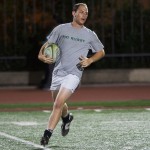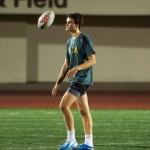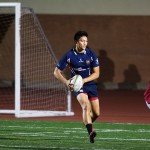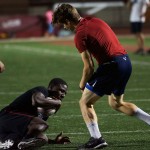Rugby alive and well at USC
Photos by Mariya Dondonyan.
There are few sports more commonly misunderstood by Americans than rugby. Like cricket, Formula One racing and, to a lesser degree, tennis, rugby has escaped the perennial American spotlight perhaps because it lacks the intrinsic “American” qualities invoked by games invented by Americans themselves: football, baseball and basketball. But football as Americans know it owes much of its basic tenets to rugby. Just ask any member of USC’s rugby club, which kicked off preseason play this weekend. Former USC football player and current rugby club president Joey Krassenstein is helming the rugby team this season, and he hopes to continue recruiting more players as the team plays its final season under the stewardship of current head coach David Lytle, who plans to retire after 26 years of coaching.
Rugby itself could be described, for the most part, by comparing it to a single college football play: The Play from 1982 Cal-Stanford game, where Cal’s team took a kick off and proceeded to throw multiple backward laterals after tackles to continue advancing the ball to score a game-winning touchdown on a single kickoff return. A rugby offense at its highest level can be summarized in that one play, with one difference: The players don’t wear pads.
“Rugby is fluid, free moving, meaning it never stops,” Krassenstein said. “It only stops for penalties.” Krassenstein insists that despite the fact that rugby players wear virtually no protective gear, the game carries a far lower risk of injury.
“There’s actually a lot less injuries, and definitely fewer career-ending injuries in rugby than in American football,” Krassenstein said. “If you asked me which sport is tougher, I’d say football. Because the play is shorter and guys are using protective gear such as shoulder pads and helmets, players go full steam ahead. In rugby if you’re going to hit someone, you have to wrap up and go down with them.”
It doesn’t make much sense in words, but when actually demonstrated, it makes sense: There’s much less to hit with, so to speak, so there isn’t as much room for high impact injuries. Rugby players tackle by lowering their shoulders, grabbing an opposing player around the waist and pulling them down. There are no “helmet-to-helmet” tackles, no “dipping the shoulder” and no players getting clocked on a hit. Because the objective in rugby is to retrieve the ball from the opposing offensive player, not to end the play by putting a player on the ground, rugby requires a more nuanced technique of tackling.
Regardless of these differences with American football, rugby is not for the faint of heart. It shares with football all of the same connotations of warriors entering into battle. At one practice, a player from USC’s rugby team emerges from a pre-practice scrimmage with a blackening eye and open wound on the side of his face, looking more suited for a Halloween party than athletic activity.
“That’s a rugby player for you,” Lytle says, chuckling. The assistant coaches advise that the player get his wound dressed immediately and bar him from practicing.
Speaking of practice, it begins promptly at 6 p.m. in Cromwell Track & Field Stadium on Tuesdays and Thursdays. A small contingent of the USC marching band’s drum line stays behind to practice on the sidelines, the hollow skittering of their snare drums ringing out into the cold air. The team files into five lines, stretching and running uniformly. The proceedings have a militaristic air about them.
After stretches, the players line up at four corners and begin to run with a ball, engaging in drills where they pass the ball — always a lateral or backward lateral — and continue to run. Lytle observes his troops fondly, like a proud, silent general, with a cup of coffee in hand. After drills, players break up into two groups: forwards and backs. Forwards practice engaging in the scrum, a large, ring-like lock between players similar to the trenches in American football — the players in this group come in all shapes and sizes, ranging from a stout, bowling-ball like student to a tall, muscular fellow who looks more like a football wide receiver than a lineman. All the players seem to have one thing in common: really strong legs that will help propel them in the scrum and push the “line of scrimmage,” so to speak, further back in their team’s favor.
Backs continue running in single file lines while simultaneously practicing their lateral passes. These distinctions are largely cosmetic; though there are players “preferred” as backs or forwards, every player contributes to the overall goal in the same way. There are no ineligible receivers in rugby, so even the largest player can carry the ball. Lytle admits this was what made him so interested in rugby.
“In football, maybe five or six guys will touch the ball,” Lytle said. “In rugby, anyone can carry the ball. Anyone can score.”
This aspect of the game is perhaps most fascinating. In rugby, a “touchdown” is actually called a “try.” Whereas in American football the ball only needs to cross the plane, in rugby football the ball needs to touch both the player and the ground — which is, ironically, where the term “touchdown” actually originated. The subsequent kick after the “try” is referred to as a “conversion.” The try is worth differing amounts of points depending on the code of play, but the kick is always worth two points. There is very little individual glory in rugby —no chest-thumping running backs celebrating in the end zone, no exuberant soccer forwards sliding across the pitch on their knees swallowing up all the commercial endorsements.
In Lytle’s team, each player is equally accountable for their team’s success in a strategic way, and all are equally capable of scoring in a given situation. Teams play with respect for one another and out of respect for the game, like in some sort of twisted fantasy world where sportsmanship still exists. Krassenstein sums up the feeling of this camaraderie in rugby with an old axiom.
“I always say that soccer is a gentleman’s game played by hooligans, and that rugby is a hooligan’s game played by gentlemen,” Krassenstein said. “We might tackle each other and hit each other, but we don’t flop for a call or play dishonestly, because there’s no room for that in rugby. At the end of the game, we shake each other’s hands like men, and we can go out for a pint.”
Euno Lee is a senior majoring in English literature. He is also the editor-in-chief of the Daily Trojan. His column, “Euno What Time It Is,” runs Tuesdays.









